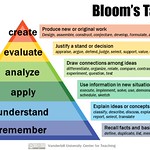Critical thinking
Critical thinking is an essential employability skill and something that needs to be intentionally taught in higher education classrooms (Conference Board of Canada). However, helping students learn these skills is not easy. Educators generally receive very little guidance on how they might best support the development of critical thinking skills. The Centre for Teaching and Learning has tried to develop resources to assist teachers with this aspect of instruction.
Facilitating higher order thinking is extremely challenging, but it is crucial in preparing students for employment, relationships, and life in a complex society.
Students are socialized to be passive learners. Moving them from being passive learners to being active thinkers requires planning and persistence.
These skills include, but are not limited to: thinking independently, look at different perspectives, support diverse perspectives with reasons and evidence, discuss ideas in an organized way, explore with questions, thinking creatively, solve problems and make decisions.
Thinking at higher levels of Bloom’s taxonomy (cognitive) recognizes the following:
- All thinking is based on assumptions
- All thinking is done from some point of view
- All thinking is based on data, information, or evidence
- All thinking contains inferences from which we draw conclusions
- All thinking leads somewhere, and has implications and/or consequences
1. Model higher order thinking (cognitive apprenticeship)
- Think about higher order thinking as a skill just like ones we would teach in an apprenticeship. Model the skills, articulate the criteria for excellence, provide opportunities for practice, coach, and finally evaluate performance on these skills.
- Stimulate your own higher order thinking by engaging in dialogue with your peers to analyze, evaluate, and synthesize information/observations related to your subject area or to teaching and learning.
- Articulate a structured approach to a common problem in the field, and then have students repeat the process with a similar problem.
- To facilitate higher order thinking:
- Encourage thoughtful “why” and “how” questions, and engage students in evaluating assumptions, points of view, data, conclusions.
- Analyze subject information sources (including the course textbook) for accuracy, objectivity, currency, and authority.
- Dissect and discuss model responses to higher order test and assignment questions
2. Structure and assess thinking activities (layered curriculum)
- Apply thinking skills to simple tasks first. Then move to more complex tasks.
- Revisit thinking processes often throughout the course.
- Design test questions based on “why” and “how” discussions in class.
- Have students work through a structured problem-solving process
- Engage students in small group activities where they have to prioritize, identify advantages and disadvantages, compare and contrast, generate a metaphor or image that incorporates certain concepts
- Brainstorm using post-its and poster paper. Have students prioritize, categorize, sequence, or group that information for a particular purpose or problem.
- Use mindmapping activities to expand thinking
- Present students with challenges and puzzles on a regular basis. Help them improve their skills
3. Formulate engaging questions
- Ask questions at higher cognitive levels, both in class and on assessments
- Have students explore questions in pairs or small groups before sharing with the class
- Facilitate Socratic dialogue
- Teach students how to support their opinions and perspectives. Then, expect it.
- Ask questions that encourage reflective discussion (i.e. What are the influences on our thinking? What are the broader impacts on society of such thinking?)
- Use the six thinking hats to explore ideas
- Engage students in dialogue that applies course concepts to something in their daily lives (TV programs, current events, social situations, etc.)
This booklet was developed as a guide for postsecondary educators as they try to facilitate learning of critical thinking skills. It includes the following:
- Definitions of critical thinking;
- Critical thinking outcomes;
- Principles and general instructional strategies for teaching critical thinking skills; and,
- Rubrics and scaffolding resources for facilitating learning of various critical thinking skills.
These scaffolding resources, from the Critical Thinking Booklet, are posted as Word documents so that they can be downloaded and edited to suit your instructional purposes:
- Scaffold #1: Formulating Meaningful Questions
- Scaffold #2: Comparing and Contrasting
- Scaffold #3: Extracting Themes and Patterns
- Scaffold #4: Analyzing Perspectives
- Scaffold #5: Designing Assignment Questions
- Scaffold #6: Annotating a Text
- Scaffold #7: Identifying Logical Fallacies
- Scaffold #8: Framework for Problem Solving
- Scaffold #9: Evaluating Information Sources
- Scaffold #10: Expressing Agreement or Disagreement for Constructive Dialogue
- Scaffold #11: Developing and Supporting an Argument
